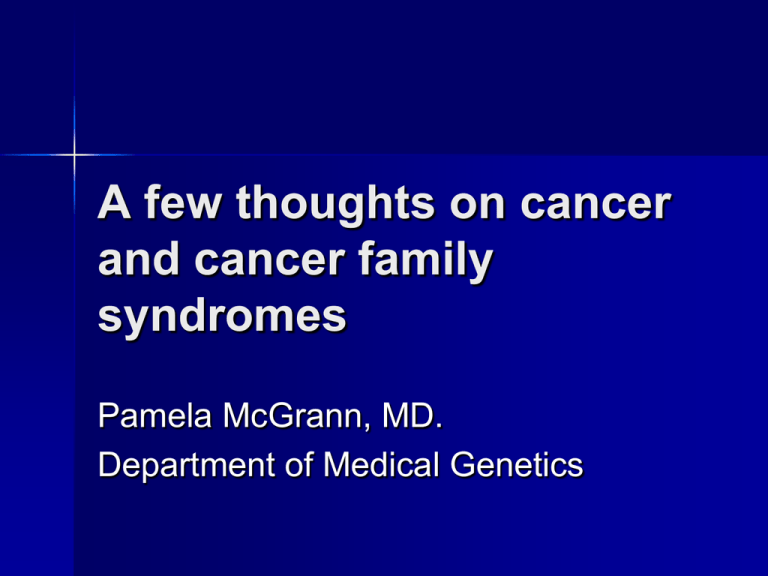A few thoughts on cancer and cancer family
advertisement

A few thoughts on cancer and cancer family syndromes Pamela McGrann, MD. Department of Medical Genetics Family cancer syndromes There are about 1.4 million new cancers diagnosed each year ~800,000 in men ~600,000 in women Cancer family syndromes Top 10 cancers Prostate Breast Lung and bronchus Colorectal lymphoma Bladder Melanoma Uterus Oropharynx renal Familial cancer syndromes ~ 30-40 % of adult deaths (nonaccidental, nonhomicidal) are due to cancer Cellular growth Cells respond to: External growth factors Steroid hormones Cell-cell interactions Cellular response to growth factors Cellular differentiation Cell growth Cell division Cell death (apoptosis) Development of cancer Cancer occurs when an accumulation of gene mutations occur that affect: Regulation of cell growth and cell division Regulation of differentiation The Knudson hypothesis Dr. Knudson studied retinoblastoma and noted: Some tumors unilateral, some bilateral Some affected kids had a family hx of retinoblastoma The Knudson hypothesis The 2 hit theory of mutagenesis and cancer PNAS 68(4):820-823, April 1971 The Knudson hypothesis In the inherited form: one mutation is inherited, and one is acquired. In the noninherited form both mutations occur in somatic cells Tumor suppressor genes The 1st tumor suppressor gene (RB1) was cloned in 1986 Homozygously inactive in all retinoblastoma tumors Tumor suppressor genes vs. oncogenes Tumor suppressor genes control cell growth If one copy is inactivated, the other copy can still accomplish the task. Tumor suppressor genes act in a recessive fashion oncogenes originate from proto-oncogenes Examples: growth factors, growth factor receptors, signal transduction proteins, nuclear transcription factors. Familial cancers characteristic features Several family members have the same or a related cancer Early age at onset of cancer (~10 yrs earlier than average age at onset of the cancer in the general population) Presence of more than 1 type of cancer in a single family member Multifocal onset or onset in paired organs Cancer family syndromes Hereditary breast and ovarian cancer Autosomal dominant Accounts for 5-10% of breast and ovarian cancers Genes – BRCA1 on chromosome 17q21 BRCA2 on 13q12.3 Cancer family syndromes BRCA1 and BRCA2 Gene frequency: BRCA1: 1/5001/1000 BRCA2: unknown BRCA1 cancer risks: breast cancer 87% by age 70 yrs. 44% ovarian cancer risk by age 70 20% risk prostate cancer 2-4% pancreatic cancer (nl <1%) BRCA2 breast cancer risk - 84% by age 70 Ovarian cancer risk - 27% by age 70 Male breast cancer risk - 6% by age 70 Familial adenomatous polyposis Autosomal dominant Incidence: 1/6000 – 1/13,000 (25-30% are spontaneous new mutations) Gene: APC Location: 5q21q22 Diagnostic features: hundreds to thousands of colonic polyps Familial adenomatous polyposis Polyps: as early as 7 years, as late as 70 yrs Most FAP patients have polyps by the late teens 100% risk for colon ca by midforties Polyps may be in duodenum and stomach too Lynch syndrome Autosomal dominant Accounts for 5 – 10% of colon cancers Genes: MLH1 at 3p21.3 MSH2 2p21 PMS1 2q32.2 PMS2 7p22 MSH6 2p16.3 Lynch syndrome: function of the genes involved Not tumor suppressor genes or oncogenes Lynch is due to DNA mismatch repair genes MMR genes encode enzymes that survey newly replicated DNA for errors and repair mismatched bases in the DNA Lynch syndrome: the cancers Colon Endometrial Transitional cell cancers of the renal collecting system Pancreatic Ovarian Lynch syndrome: penetrance Lynch syndrome The first of our 4 grads this spring!







